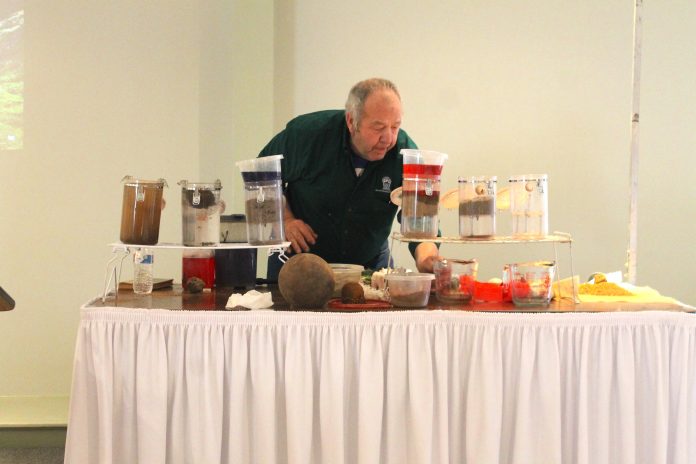
PROSPECT, Pa. — “We need to regain soil functions — that is at the root of a lot of our problems,” said Barry Fisher with USDA’s Natural Resources Conservation Service.
“In all my years, I’ve never come across a program or practice that has the relevance of soil health,” said Fisher, who is a 36-year veteran in soil health, to more than 80 attendees at the Western Pennsylvania Soil Health Workshop last week.
The soil needs to be managed as a vital, living ecosystem, he said, comparing it to a dog in a hot car.
“The soil is not the Cadillac, it’s the dog that needs fed and nurtured.”
No-till is one part of the soil health equation, but it is more than the absence of tillage, Fisher said.
“The goal is to restore aggregate stability; resist erosion, filtrate water and stay in place,” he said.
He suggested four steps in doing so:
1. Minimize disturbances
2. Maximize soil cover
3. Maximize biodiversity
4. Provide continuous living roots
Cover crops
Every benefit of cover crops is tied to the processing of carbon — to capture the sun’s free energy through photosynthesis and get those nutrients down into the soil.
“Don’t let your resources get away from you. That is what cover crops are so good at, keeping your resources in place,” Fisher said.
Western Pa. dairyman Ed Thiele bought his first no-till planter in 1988 and now uses a seven-grain cocktail on some fields to get a diverse mixture of plant species in the ground, following Fisher’s third and fourth tips in maximizing biodiversity and keeping live roots in the ground.
“You’ve got to have enough guts to try it,” he said about planting cover crops late in the year. He said his last soybean field came off Dec. 4 this past year and the planter followed right behind planting cereal rye.
“I just know that is going to green up with the weather breaks,” he said. “I have a no-quit attitude. If you can get into the field, do it.”
Demonstration
Leroy Bupp with the Pennsylvania No-Till Alliance demonstrated soil volatility to the audience, visualizing the qualities of healthy soil.
“Leave the soil alone,” he told the audience, as his “tilled sample” fell to the bottom of a water-filled beaker and his “healthy sample” stayed afloat.
Bupp, who milked cows for 52 years, started no-tilling in 1974.
Critters
He also demonstrated how worms breed and how they help the soil, claiming plowing kills 50 percent of worms and 80 percent of their cocoons.
Keeping good critters in the soil and removing the bad is key.
Chris Pilgram of Mercer County has been no-till farming for 20 years, but with the increasing slug problems in his soybeans, he has gone back to plowing.
“They go along the row and just pick off every seed in their path,” Pilgram said.
Fisher believes the extensive slug problem is triggered by the overuse of pesticides, because pesticide-treated seeds kill worms that turn into beetles.
“Those beetles eat the slugs, but we’ve killed off the predator,” Fisher said.
“We want to use the method — see the pest, treat the pest — rather than insure against the pest with treated seeds.”
Pilgram noted, that is all well, but that if you don’t treat your seeds, some crop insurers won’t insure your replant.
“You have decide if you are going to treat your seed in January and you don’t know what type of growing season you will get into,” Pilgram said.
The journey
Some issues that arise in a no-till system are still being tinkered with, like slugs and making sure there is enough nitrogen for corn during emergence, but each growing season, farmers and researchers alike improve their soil health strategies.
“This is not fu-fu we are talking about — this is real yield capacity. Your fields yield higher with improved soil health,” Fisher said. “Soil health is not a destination, it is a journey.”










